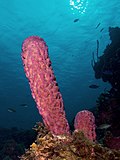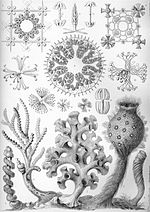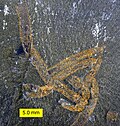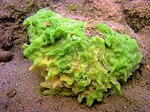spongocytes. Spongin gives a sponge its flexibility. True spongin is found only in members of the class Demospongiae. Researchers have found spongin to be useful...
2 KB (221 words) - 15:00, 1 March 2021
(skeletal-like fragments of calcium carbonate or silicon dioxide), and/or spongin (a modified type of collagen protein). An internal gelatinous matrix called...
132 KB (13,366 words) - 21:15, 29 October 2024
the family Grantiidae. Species of the genus Grantia contain spicules and spongin fibers. The genus contains bioluminescent species. Grantia aculeata Urban...
4 KB (312 words) - 19:28, 3 August 2021
Their "skeletons" are made of spicules consisting of fibers of the protein spongin, the mineral silica, or both. Where spicules of silica are present, they...
24 KB (2,477 words) - 15:38, 6 November 2024
"skeleton" consists of microscopic calcareous or siliceous spicules or a spongin network. The Coleoidea do not have a true endoskeleton in the evolutionary...
5 KB (590 words) - 10:58, 8 July 2024
demosponges. Keratosa sponges are nonspicular demosponges with organic spongin fibers forming flexible skeletons. Recently discovered in the Andaman and...
2 KB (242 words) - 18:03, 30 October 2024
within the phylum Porifera. The "skeleton" in these sponges is made up of spongin, rather than of spicules. They live in marine environments. The name was...
2 KB (85 words) - 04:48, 8 March 2021
motile bacterium from the genus of Aquimarina which has been isolated from spongin. "Aquimarina". LPSN. "Aquimarina spongiicola". www.uniprot.org. Choi, KD;...
1 KB (70 words) - 02:56, 8 February 2022
Kópavogur, Fjörður in Hafnarfjörður, Ásgarður in Garðabær, Ártún, Mjódd, Spöngin in Reykjavík and Háholt in Mosfellsbær. All of these main bus terminals...
16 KB (1,969 words) - 11:48, 6 November 2024
Their "skeletons" are made of spicules consisting of fibers of the protein spongin, the mineral silica, or both. Where spicules of silica are present, they...
31 KB (3,620 words) - 08:30, 5 November 2024
thought to be, at least in part, because their spicules are sturdier than spongin and fossilize better. Like almost all sponges, the hexactinellids draw...
20 KB (2,304 words) - 15:07, 8 October 2024
branch consisted of a network of strands. Vauxia also had a skeleton of spongin (flexible organic material) common to modern day sponges. Much like Choia...
4 KB (243 words) - 10:27, 20 September 2024
skeleton is minimal or absent and a skeleton of organic fibers containing spongin, a collagen-like material, is present instead. Wikimedia Commons has media...
2 KB (206 words) - 22:03, 12 December 2023
are generally characterized by concentric layers of fibers containing spongin (a collagen-like material), and by large flagellated chambers that open...
2 KB (182 words) - 09:09, 27 March 2023
of spongin and inclusions such as sand grains and spicules. The secondary fibers are 20 to 35 nanometers in diameter and are composed of only spongin without...
18 KB (2,053 words) - 13:38, 31 December 2023
sponges in this class have skeletons made from silicon-containing spicules, spongin fibers, or both. Demosponges include both marine and freshwater sponges...
9 KB (960 words) - 22:53, 25 October 2023
through a hole called the osculum. Many sponges have internal skeletons of spongin and/or spicules of calcium carbonate or silicon dioxide. All sponges are...
304 KB (29,025 words) - 18:15, 4 November 2024
calcareous or siliceous. Siliceous spicules are sometimes embedded in spongin. Spicules are found in a range of symmetry types. Monaxons form simple...
71 KB (7,846 words) - 15:12, 2 November 2024
increased urinary levels are associated with the extent of renal injury. Spongin, a variant of this collagen type found in some animals Boute N, Exposito...
21 KB (2,425 words) - 14:05, 9 October 2024
that had a distinctive branching mode of growth. Vauxia had a skeleton of spongin (flexible organic material) common to modern day sponges. Much like Choia...
78 KB (1,489 words) - 19:05, 16 September 2024
differ. Among the class Demospongiae, skeletons are formed mainly of spongin. Spongin is the main component that makes up the sponge skeleton. While sponges...
9 KB (736 words) - 20:36, 1 October 2024
through a hole called the osculum. Many sponges have internal skeletons of spongin and/or spicules of calcium carbonate or silicon dioxide. All sponges are...
63 KB (6,568 words) - 03:23, 8 October 2024
estate. Grafarvogur currently has one medium-sized shopping centre called Spöngin. It's not a mall in itself but a cluster of stores, Hagkaup being the largest...
4 KB (243 words) - 02:39, 30 June 2024
or exceptionally 50 metres (160 ft). Some authorities report that the spongin fibres contain no coring spicules while others report that there are some...
5 KB (399 words) - 07:08, 25 January 2022
Demosponges appear: form first skeletons of spicules made from protein spongin and silica – brightly coloured these colonial creatures filter feed since...
64 KB (7,755 words) - 23:56, 13 October 2024
secreting a kind of skeleton for supporting the sponge's body, formed of spongin fibers. As its name suggests, the most common color is blue, but individuals...
4 KB (378 words) - 08:20, 30 April 2024
elimination, and support element production. Such support elements (e.g., spongin and spicules) are also found in the mesohyl layer. This species has a leuconoid...
21 KB (2,064 words) - 23:58, 2 August 2024
detailed structure of chancellorid sclerites is similar to that of fibers of spongin, a collagen protein, in modern keratose (horny) demosponges such as Darwinella...
18 KB (1,985 words) - 12:23, 19 June 2024
not necessarily have spicules and instead may depend on a collagenous spongin and chitin skeleton for support. This sponge is covered in tiny oscules...
12 KB (1,214 words) - 14:04, 5 June 2024
detailed structure of chancellorid sclerites is similar to that of fibers of spongin, a collagen protein, in modern keratose (horny) demosponges. However Janussen...
63 KB (6,415 words) - 14:52, 14 July 2024























